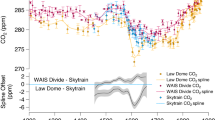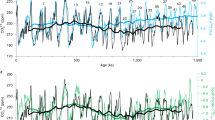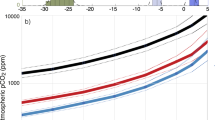Abstract
Sea-level proxy records and palaeoclimate models suggest that globally elevated temperatures during the greenhouse climate of the Jurassic were punctuated by poorly understood, transient icehouse events. Here we investigate atmospheric CO2–ice-sheet dynamics as a case study from the Early Jurassic Pliensbachian–Toarcian transition (182.7–180.6 million years ago). Applying the C3 CO2 plant proxy to previously published fossil wood data reveals that CO2 levels during this transition ranged from 250 to 400 ppm. Previously published belemnite δ18O values suggest that sea-level low stands were equivalent to ice volumes up to two-thirds of Antarctica today. Beginning with the Toarcian ocean anoxic event, these ice sheets largely melted when CO2 reached sustained concentrations of ~500–700 ppm. Compared with the Cenozoic East Antarctic Ice Sheet and ice sheets modelled for the Middle Jurassic, Early Jurassic ice sheets exhibit minimal lags (hysteresis) between warming and cooling limbs, suggesting they were thin and located at lower latitudes and elevations with a higher temperature sensitivity to melting. These sensitivities of ice volume to CO2 provide additional constraints on climate models for application to warming transitions in both the past and future.
This is a preview of subscription content, access via your institution
Access options
Access Nature and 54 other Nature Portfolio journals
Get Nature+, our best-value online-access subscription
$29.99 / 30 days
cancel any time
Subscribe to this journal
Receive 12 print issues and online access
$259.00 per year
only $21.58 per issue
Buy this article
- Purchase on Springer Link
- Instant access to full article PDF
Prices may be subject to local taxes which are calculated during checkout




Similar content being viewed by others
Data availability
All values from wood and bulk carbonate δ13C to compute atmospheric CO2 concentrations and all values from the δ18O of belemnites for sea-level estimates were compiled from other sources as discussed in the main text and Methods section. Readers may contact L.N. if additional information is needed from this manuscript.
References
Haq, B. U. Jurassic sea-level variations: a reappraisal. GSA Today 28, 4–10 (2017).
Sahagian, D., Pinous, O., Olferiev, A. & Zakharov, V. Eustatic curve for the Middle Jurassic–Cretaceous based on Russian platform and Siberian stratigraphy: zonal resolution. Am. Assoc. Pet. Geol. Bull. 80, 1433–1458 (1996).
Donnadieu, Y. et al. A mechanism for brief glacial episodes in the Mesozoic greenhouse. Paleoceanography 26, PA3212 (2011).
Korte, C. & Hesselbo, S. P. Shallow marine carbon and oxygen isotope and elemental records indicate icehouse–greenhouse cycles during the Early Jurassic. Paleoceanography 26, PA4219 (2011).
Dromart, G. et al. Ice age at the Middle–Late Jurassic transition? Earth Planet. Sci. Lett. 213, 205–220 (2003).
Price, G. D. The evidence and implications of polar ice during the Mesozoic. Earth Sci. Rev. 48, 183–210 (1999).
Rogov, M. A. & Zakharov, V. A. Jurassic and Lower Cretaceous glendonite occurrences and their implication for Arctic paleoclimate reconstructions and stratigraphy. Earth Sci. Front. 17, 345–347 (2010).
Teichert, B. M. A. & Luppold, F. W. Glendonites from an Early Jurassic methane seep—climate or methane indicators? Palaeogeogr. Palaeoclimatol. Palaeoecol. 390, 81–93 (2013).
Suan, G. et al. Polar record of Early Jurassic massive carbon injection. Earth Planet. Sci. Lett. 312, 102–113 (2011).
Brandt, K. Glacioeustatic cycles in the Early Jurassic? Neues Jahrb. Geol. Palaontol. Abh. 5, 257–274 (1986).
Woolfe, K. J. & Francis, J. E. An Early to Middle Jurassic glaciation-evidence from Allan Hills, Transantarctic Mountains. In Proc. 6th International Symposium on Antarctic Earth Sciences, Japan 652–653 (1991).
Dera, G. & Donnadieu, Y. Modeling evidences for global warming, Arctic seawater freshening, and sluggish oceanic circulation during the early Toarcian anoxic event. Paleoceanography 27, PA2211 (2012).
Silva, R. C. & Duarte, L. V. Organic matter production and preservation in the Lusitanian Basin (Portugal) and Pliensbachian climatic hots snaps. Glob. Planet. Change 131, 24–34 (2015).
Gómez, J. J., Comas-Rengifo, M. J. & Goy, A. Paleoclimatic oscillations in the Pliensbachian (Early Jurassic) of the Asturian Basin (Northern Spain). Clim. Past 12, 1199–1274 (2016).
Suan, G. et al. Secular environmental precursors to early Toarcian (Jurassic) extreme climate changes. Earth Planet. Sci. 290, 448–458 (2010).
Fantasia, A. et al. Global versus local processes during the Pliensbachian–Toarcian transition at the Peniche GSSP, Portugal: a multi-proxy record. Earth Sci. Rev. 198, 2932 (2019).
Sell, B. et al. Evaluating the temporal link between the Karoo LIP and climatic–biologic events of the Toarcian Stage with high-precision U-Pb geochronology. Earth Planet. Sci. Lett. 408, 48–56 (2014).
Hesselbo, S. P. et al. Massive dissociation of gas hydrate during a Jurassic oceanic anoxic event. Nature 406, 392–395 (2000).
Hesselbo, S. P., Jenkyns, H. C., Duarte, L. V. & Oliveira, L. C. V. Carbon-isotope record of the Early Jurassic (Toarcian) ocean anoxic event from fossil wood and marine carbonate (Lusitanian Basin, Portugal). Earth Planet. Sci. Lett. 253, 455–470 (2007).
Schubert, B. A. & Jahren, A. H. Incorporating the effects of photorespiration into terrestrial paleoclimate reconstruction. Earth Sci. Rev. 177, 637–642 (2018).
Miller, K. G., Wright, J. D. & Browning, J. V. Visions of ice sheets in a greenhouse world. Mar. Geol. 217, 215–231 (2005).
Gómez, J. J., Goy, A. & Canales, M. L. Seawater temperature and carbon isotope variations in belemnites linked to mass extinction during the Toarcian (Early Jurassic) in Central and Northern Spain. Comparison with other European sections. Palaeogeogr. Palaeoclimatol. Palaeoecol. 258, 28–58 (2008).
Rosales, I., Quesada, S. & Robles, S. Paleotemperature variations of Early Jurassic seawater recorded in geochemical trends of belemnites from the Basque–Cantabrian basin, northern Spain. Palaeogeogr. Palaeoclimatol. Palaeoecol. 203, 253–275 (2004).
van de Schootbrugge, B. et al. Early Jurassic climate change and the radiation of organic-walled phytoplankton in the Tethys Ocean. Paleobiology 31, 73–97 (2010).
Vera, E. I. & Césari, S. N. New species of conifer wood from the Baqueró Group (Early Cretaceous) of Patagonia. Ameghiniana 52, 468–471 (2015).
Wilson, J. P. et al. Dynamic Carboniferous tropical forests: new views of plant function and physiological forcing of climate. New Phytol. 215, 1333–1353 (2017).
Lomax, B. H., Lake, J. A., Leng, M. J. & Jardine, P. E. An experimental evaluation of the use of Δ13C as a proxy for palaeoatmospheric CO2. Geochim. Cosmochim. Acta 247, 162–174 (2019).
Tipple, B. J., Meyers, S. R. & Pagani, M. Carbon isotope ratio of Cenozoic CO2: a comparative evaluation of available geochemical proxies. Paleoceanography 25, PA3202 (2010).
Diefendorf, A. F., Freeman, K. H. & Wing, S. L. Distribution and carbon isotope patterns of diterpenoids and triterpenoids in modern temperate C3 trees and their geochemical substantial. Geochim. Cosmochim. Acta 85, 342–356 (2012).
Lenton, T. M., Daines, S. J. & Mills, B. J. W. COPSE reloaded: an improved model of biogeochemical cycling over Phanerozoic time. Earth Sci. Rev. 178, 1–28 (2018).
McElwain, J. C., Wade-Murphy, J. & Hesselbo, S. P. Changes in carbon dioxide during an oceanic anoxic event linked to intrusion into Gondwana coals. Nature 435, 479–482 (2005).
Ruebsam, W., Reolid, M. & Schwark, L. δ13C of terrestrial vegetation records Toarcian CO2 and climate gradients. Sci. Rep. 10, 117 (2020).
Huang, C. & Hesselbo, S. P. Pacing of the Toarcian oceanic anoxic event (Early Jurassic) from astronomical correlation of marine sections. Gondwana Res. 25, 1348–1356 (2014).
Fung, M. K., Katz, M. E., Miller, K. G., Browning, J. V. & Rosenthal, Y. Sequence stratigraphy, micropaleontology, and foraminiferal geochemistry, Bass River, New Jersey paleoshelf, USA: implications for Eocene ice-volume changes. Geosphere 15, 502–532 (2019).
Oerlemans, J. A model of the Antarctic ice sheet. Nature 297, 550–553 (1982).
Esch, M. B. & Herterich, K. A two-dimensional coupled atmosphere–ice sheet–continent model designed for paleoclimatic simulations. Ann. Glaciol. 14, 55–57 (1990).
Foster, G. L. & Rohling, E. J. Relationship between sea level and climate forcing by CO2 on geological timescales. Proc. Natl Acad. Sci. USA 110, 1209–1214 (2013).
Gasson, E., DeConto, R. M., Pollard, D. & Levy, R. H. Dynamic Antarctic ice sheet during the early to mid-Miocene. Proc. Natl Acad. Sci. USA 113, 3459–3464 (2016).
Booth, B. B. et al. Narrowing the range of future climate projections using historical observations of atmospheric CO2. J. Clim. 30, 3039–3053 (2017).
Hesselbo, S. P. & Pienkowski, G. Stepwise atmospheric carbon-isotope excursion during the Toarcian oceanic anoxic event (Early Jurassic, Polish Basin). Earth Planet. Sci. Lett. 301, 365–372 (2011).
Storm, M. S. et al. Orbital pacing and secular evolution of the Early Jurassic carbon cycle. Proc. Natl Acad. Sci. USA 117, 3974–3982 (2020).
Jenkyns, H. C. & Clayton, C. J. Lower Jurassic epicontinental carbonates and mudstones from England and Wales: chemostratigraphic signals and the early Toarcian anoxic event. Sedimentology 44, 687–706 (1997).
Hermoso, M., Minoletti, F. & Pellenard, P. Black shale deposition during Toarcian super-greenhouse driven by sea level. Clim. Past 9, 2703–2712 (2013).
Schouten, S., van Kaam-Peters, M. E., Rijpstra, W. I. C., Schoell, M. & Damste, J. S. S. Effects of an oceanic anoxic event on the stable carbonate isotopic composition of early Toarcian carbon. Am. J. Sci. 300, 1–22 (2000).
Sabatino, N. et al. Carbon-isotope records of the Early Jurassic (Toarcian) oceanic anoxic event from the Valdobia (Umbria-Marche Apennines) and Monte Mangart (Julian Alps) sections: palaeooceaogrpahic and stratigraphic implications. Sedimentology 56, 1307–1328 (2009).
Garbe, J., Albrecht, T., Levermann, A., Donges, J. & Winkelmann, R. The hysteresis of the Antarctic Ice Sheet. Nature 585, 538–544 (2020).
Suan, G., Mattioli, E., Pittet, B., Mailliot, S. & Lécuyer, C. Evidence for major environmental perturbation prior to and during the Toarcian (Early Jurassic) oceanic anoxic event form the Lusitanian Basin, Portugal. Paleoceanography 23, PA1202 (2008).
Müller, T. et al. New multiproxy record of the Jenkyns Event (also known as the Toarcian anoxic event) from the Mecsek Mountains (Hungary): differences, duration and drivers. Sedimentology 64, 66–86 (2017).
Ogg, J. G. & Hinnov, A. L. in The Geologic Time Scale 2012 (eds Gradstein, F. M. et al.) Ch. 26 (Elsevier, 2012).
McCarroll, D. & Loader, N. J. Stable isotopes in tree rings. Quat. Sci. Rev. 23, 771–801 (2004).
Voelker, S. L. et al. A dynamic leaf gas-exchange strategy is conserved in woody plants under changing ambient CO2: evidence from carbon isotope discrimination in paleo and CO2 enrichment studies. Glob. Change Biol. 22, 889–902 (2016).
Tholen, D. & Zhu, X. G. The mechanistic basis of internal conductance: a theoretical analysis of mesophyll cell photosynthesis and CO2 diffusion. Plant Physiol. 156, 90–105 (2011).
Cui, Y. & Schubert, B. A. Quantifying the uncertainty of past pCO2 determined from changes in C3 plant carbon isotope fractionation. Geochim. Cosmochim. Acta 172, 127–138 (2016).
Schubert, B. A. & Jahren, A. H. The effect of atmospheric CO2 concentration on carbon isotope fractionation in C3 land plants. Geochim. Cosmochim. Acta 96, 29–43 (2012).
Philippe, M. et al. The palaeolatitudinal distribution of fossil wood genera as a proxy for European Jurassic terrestrial climate. Palaeogeogr. Palaeoclimatol. Palaeoecol. 466, 373–381 (2017).
Zhou, Z. A heterophyllous conifer from the Cretaceous of East China. Palaeontology 26, 789–811 (1983).
Farjon A. A. Natural History of Conifers (Timber Press, 2008).
Diefendorf, A. F., Mueller, K. E., Wing, S. L., Koch, P. L. & Freeman, K. H. Global patterns in leaf 13C discrimination and implications for studies of past and future climate. Proc. Natl Acad. Sci. USA 107, 5738–5743 (2010).
Kohn, M. J. Carbon isotope compositions of terrestrial C3 plants as indicators of (paleo)ecology and (paleo)climate. Proc. Natl Acad. Sci. USA 107, 19691–19695 (2010).
Schlesser, G. H., Helle, G., Lücke, A. & Vos, H. Isotope signals as climate proxies: the role of transfer functions in the study of terrestrial archives. Quat. Sci. Rev. 18, 927–943 (1999).
Silva, R. L., Duarte, L. V. & Filho, J. G. M. Optical and geochemical characterization of upper Sinemurian (Lower Jurassic) fossil wood from the Lusitanian Basin (Portugal). Geochem. J. 47, 489–498 (2013).
Lukens, W. E., Eze, P. & Schubert, B. A. The effect of diagenesis on carbon isotope values of fossil wood. Geology 47, 987–991 (2019).
Armendáriz, M. et al. An approach to estimate Lower Jurassic seawater oxygen isotope composition using δ18O and Mg/Ca ratios of belemnite calcites (early Pliensbachian, northern Spain). Terra Nova 25, 439–445 (2013).
Lear, C. H., Elderfield, H. & Wilson, P. A. Cenozoic deep-sea temperatures and global ice volumes from Mg/Ca in benthic foraminiferal calcite. Science 287, 269–272 (2000).
Hollis, C. J. et al. The DeepMIP contribution to PMIP4: methodologies for selection, compilation and analysis of latest Paleocene and early Eocene climate proxy data, incorporating version 0.1 of the DeepMIP database. Geosci. Model Dev. 12, 3149–3206 (2019).
Rosales, I. et al. Isotope records (C–O–Sr) of late Pliensbachian–early Toarcian environmental perturbations in the westernmost Tethys (Majorca Island, Spain). Palaeogeogr. Palaeoclimatol. Palaeoecol. 497, 168–185 (2018).
Val, J., Bádenas, B., Aurell, M. & Rosales, I. Cyclostratigraphy and chemostratigraphy of a bioclastic storm-dominated carbonate ramp (late Pliensbachian, Iberian Basin). Sediment. Geol. 355, 93–113 (2017).
Grossman, E. in The Geologic Time Scale 2012 (eds Gradstein, F. M. et al.) Ch. 10 (Elsevier, 2012).
Ruebsam, W., Munzberger, P. & Schwark, L. Chronology of the early Toarcian environmental crisis in the Lorraine Sus-Basin (NE Paris Basin). Earth Planet. Sci. Lett. 404, 273–282 (2014).
Pittet, B., Suan, G., Fabien, L., Duarte, L. V. & Mattioli, E. Carbon isotope evidence for sedimentary discontinuities in the lower Toarcian of the Lusitanian Basin (Portugal): sea level change at the onset of the oceanic anoxic event. Sediment. Geol. 303, 1–14.
Royer, D. L., Pagani, M. & Beerling, D. J. Geobiological constraints on Earth system sensitivity of CO2 during the Cretaceous and Cenozoic. Geobiology 10, 298–310 (2012).
Metodiev, L. & Koleva-Rekalova, E. Stable isotope records (δ18O and δ13C) of Lower–Middle Jurassic belemnites from the Western Balkan mountains (Bulgaria): palaeoenvironmental application. Appl. Geochem. 23, 2845–2856 (2008).
McArthur, J. M., Donovan, D. T., Thirlwall, M. F., Fouke, B. W. & Mattey, D. Strontium isotope profile of the early Toarcian (Jurassic) oceanic anoxic event, the duration of ammonite biozones, and belemnite palaeotemperatures. Earth Planet. Sci. Lett. 179, 269–285 (2000).
Jenkyns, H. G., Jones, C. E., Gröcke, D., Hesselbo, S. P. & Parkinson, D. N. Chemostratigraphy of the Jurassic System: applications, limitations and implications for palaeoceanography. J. Geol. Soc. Lond. 159, 351–378 (2002).
Ullmann, C. V., Thibault, N., Ruhl, M., Hesselbo, S. P. & Korte, C. Effect of a Jurassic oceanic anoxic event on belemnite ecology and evolution. Proc. Natl Acad. Sci. USA 111, 10073–10076 (2014).
Harazim, D. et al. Spatial variability of watermass conditions within the European Epicontinental Seaway during the Early Jurassic (Pliensbachian–Toarcian). Sedimentology 60, 359–390 (2010).
Dera, G. et al. Water mass exchange and variations in seawater temperature in the NW Tethys during the Early Jurassic: evidence from neodymium and oxygen isotopes of fish teeth and belemnites. Earth Planet. Sci. Lett. 286, 198–207 (2009).
Bailey, T. R., Rosenthal, Y., McArthur, J. M., van de Schootbrugge, B. & Thirlwall, M. F. Paleoceanographic changes of the late Pliensbachian–early Toarcian interval: a possible link to the genesis of an oceanic anoxic event. Earth Planet. Sci. Lett. 212, 307–320 (2003).
Montañez, I. P. & Poulsen, C. J. The late Paleozoic ice age: an evolving paradigm. Annu. Rev. Earth Planet. Sci. 41, 629–656 (2013).
Ahokas, J. M., Nystuen, J. P. & Martinius, A. W. Stratigraphic signatures of punctuated rise in relative sea-level in an estuary-dominated heterolithic succession: incised valley fills of the Toarcian Ostrealv Formation, Neill Klinter Group (Jameson Land, East Greenland). Mar. Pet. Geol. 50, 103–129 (2014).
Krencker, F.-C., Kindstrom, S. & Bodin, S. A major sea-level drop briefly precedes the Toarcian oceanic anoxic event: implication for Early Jurassic climate and carbon cycle. Sci. Rep. 9, 12518 (2014).
Marjanac, T. & Steel, R. J. Dunlin Group sequence stratigraphy in the northern North Sea: a model for Cook Sandstone deposition. Am. Assoc. Pet. Geol. Bull. 81, 276–292 (1997).
Acknowledgements
We thank H. Jahren for comments that improved the clarity of the manuscript. S. Hesselbo kindly provided his previously published stable carbon and oxygen data from the Peniche study area.
Author information
Authors and Affiliations
Contributions
L.N. and D.B. designed the study. J.W. helped provide the underlying assumptions and plant physiological interpretations of the C3 plant CO2 proxy. L.N. wrote the main part of the paper in consultation with D.B. and J.W.
Corresponding author
Ethics declarations
Competing interests
The authors declare no competing interests.
Peer review information
Nature Geoscience thanks Michaël Hermoso and the other, anonymous, reviewer(s) for their contribution to the peer review of this work. Primary Handling Editor: James Super.
Additional information
Publisher’s note Springer Nature remains neutral with regard to jurisdictional claims in published maps and institutional affiliations.
Extended data
Extended Data Fig. 1 δ18O belemnite values from the Western Tethys.
Note general congruence of data prior to the T-CIE, and greater scattering during and after. Study areas in the northern Tethys (Bulgaria72; Yorkshire, UK, plus symbol73; Yorkshire, UK, gray square74; Yorkshire, UK, orange circle75; S. France76; Belgium77; Germany78; and S. France77) were likely influenced by freshwater lowering δ18O values during the T-CIE, where because of anoxia, belemnites may have migrated to warmer surface habitats further lowering isotopic values50. Scattered δ18O values after the T-CIE are attributed to the evolution of new belemnite species adapted to different habitats in the water column50. Data from Portugal and Spain (N. Spain, gray circle23; N. Spain, blue circle22; N. Spain, red circle24; Portugal, green circles19) were influenced less by freshwater and anoxia, and used for the sea level computations.
Supplementary information
Supplementary Tables
Supplementary Tables 1–8.
Rights and permissions
About this article
Cite this article
Nordt, L., Breecker, D. & White, J. Jurassic greenhouse ice-sheet fluctuations sensitive to atmospheric CO2 dynamics. Nat. Geosci. 15, 54–59 (2022). https://doi.org/10.1038/s41561-021-00858-2
Received:
Accepted:
Published:
Issue Date:
DOI: https://doi.org/10.1038/s41561-021-00858-2
This article is cited by
-
Orbital pacing and secular evolution of lake-level changes reconstructed by sedimentary noise modeling during the Early Jurassic icehouses-(super)greenhouses
Science China Earth Sciences (2024)
-
Glendonite-bearing concretions from the upper Pliensbachian (Lower Jurassic) of South Germany: indicators for a massive cooling in the European epicontinental sea
Facies (2023)



